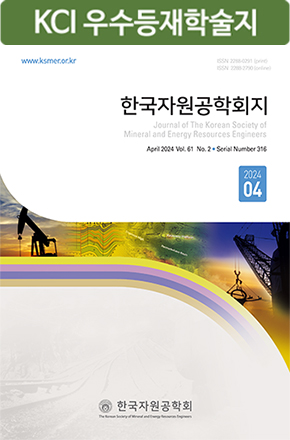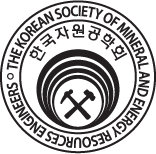- 고일원, 이상우, 김주용, 김경웅, 이진수, 전효택, 정명채, 2003, “국내 폐금은 광산주변의 비소 및 중금속의 오염 가능성과 복원 순위”, 한국지구시스템공학회지, 제40권 5호, pp. 367-378.
- 송원경, 허승, 김태혁, 2008, “GIS 기법을 이용한 광미댐 수문 분석”, 터널과 지하공간, 제18권 5호, pp. 375-385.
- 이평구, 2004, “체계적인 폐광산지역 중금속 오염 평가와 경제적인 복원을 위한 문제제기”, 제130회 정책 &지식포럼, 한국정책지식센터, http://www.know.or.kr.
- 한국광해관리공단, 2008, 삼광광산 광물찌꺼기 유실방지사업 정밀조사, p. 93.
- 한국광해관리공단, 2009, 광해방지사업 기초자료 확보를 위한 연구보고서, p. 88.
- 한국광해관리공단, 2011.06.30, www.mireco.or.kr.
- 한국일보, 2002.09.09, 호우붕괴 봉화 금정광산 실태조사, http://news.naver.com/main/read.nhn?mode=LSD&mid=sec&sid1=102&oid=038&aid=0000151417.
- Ayad, Y., Ryberg, P., Bernecky, V. and Hnet, J., 2003, “Impacts of Acid Mine Drainage: Building Streams Database and Analyzing Toby Creek Sub-Basin”, Proc. of the 23rd Annual Esri International User Conference, San Diego, California, USA, July 7-11, pp. 1-15.
- Choi, Y., Park, H.D. and Sunwoo, C., 2008, “Flood and gully erosion problems at the Pasir open pit coal mine, Indonesia: a case study of the hydrology using GIS”, Bulletin of Engineering Geology and the Environment, Vol. 67, No. 2, pp. 251-258.
- Chow, V.T., 1988, Applied hydrology, McGraw-Hill, New York, USA, pp. 155-159.
- Fairfield, J. and Leymarie, P., 1991, “Drainage networks from grid digital elevation models”, Water Resources Research, Vol. 27, Issue 5, pp. 709-717.
- Gallant, J.C. and Wilson, J.P., 2000, Terrain Analysis: Principles and Applications, John Wiley & Sons, New York, USA, pp. 51-86.
- Jenson, S.K. and Domingue, J.O., 1988, “Extracting topographic structure from digital elevation data for geographic information system analysis”, Photogrammetric Engineering & Remote Sensing, Vol. 54, pp. 1593-1600.
- O’Callaghan, J.F. and Mark, D.M., 1984, “The extraction of drainage networks from digital elevation data”, Computer Vision Graphics Image Processes, Vol. 28, pp. 328-344.
- Raaflaub, L.D., 2002, The Effect of Error in Gridded Digital Elevation Models on Topographic Analysis and on the Distributed Hydrological Model TOPMODEL, UCGE Report No. 20163, Department of Geomatics Engineering, University of Calgary, Calgary, Alberta, p. 113.
- Soil Conservation Service, 1972, National Engineering Handbook, section 4, Hydrology, U. S. Dept. of Agriculture, available from U. S. Government Printing Office, Washington, D.C., USA.
- Tamas, J. and Kovacs, E., 2003, “Evaluation of Migration of Heavy Metal Containing Sediment Resulting from Water Erosion using a Geo Information Model”, Proc. of the EFITA 2003 Conference, Debrecen, Hungary, July 5-9, pp. 796-800.
- Yenilmez, F., Kyter, N., Emil, M.K. and Aksoy, A., 2011, “Evaluation of pollution levels at an abandoned coal mine site in Turkey with the aid of GIS”, International Journal of Coal Geology, Vol. 86, No. 1, pp. 12-19.
- Publisher :The Korean Society of Mineral and Energy Resources Engineers
- Publisher(Ko) :한국자원공학회
- Journal Title :Journal of the Korean Society for Geosystem Engineering
- Journal Title(Ko) :한국지구시스템공학회지
- Volume : 48
- No :5
- Pages :560-572



 Journal of the Korean Society of Mineral and Energy Resources Engineers
Journal of the Korean Society of Mineral and Energy Resources Engineers








